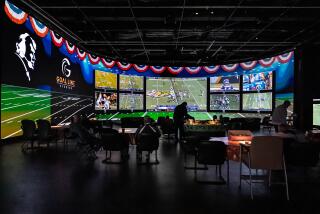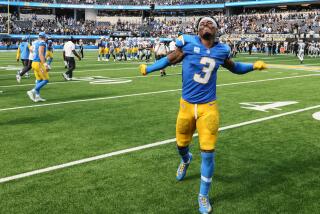Raiders’ Armorer : ‘Romo’ is the Man Who Keeps Team in Pads and Cleats
- Share via
It is corns and bunions that occupy part of the morning for Dick Romanski.
Romanski, for 25 years the equipment man of the Los Angeles Raiders football team, is demonstrating how he prepares cleats for athletes with less-than-perfect feet.
It is a slow time at the Raiders’ training facility in El Segundo, a morning dulled by gray overcast. The closet-like equipment room, once bustling with children at this closed elementary school, is shrouded in silver and black. The Raider colors are everywhere, even on the suspenders Romanski uses to hold up his black shorts.
The son of a Milwaukee cobbler, Romanski grabs an odd-looking shoehorn from a workbench and shoves it into the toe of his own black shoe to demonstrate.
“You got a guy with a corn on his foot here,” he says, stretching the leather with the device, one of his father’s hand tools. “You just put a little pressure here, where it is, and, see, all it leaves is a little mark on the shoe.”
Tricks like that-- ad libbing is what he calls it--are part of the mystique that the man called “Romo” adds to the rough-and-tumble Raider image.
Romanski, 61, was a hockey and football player in Wisconsin in his youth. He entered the Army in the 1950s. One of the men in his unit was Al Davis. Davis wanted to be a football coach once his hitch in the service was through. Romanski liked that idea, too. He joined the Raiders and their eventual owner, Davis, in 1961 as a scout. Two years later, failing eyesight drove him out of the press box and into the equipment room.
The team was in Oakland in those days. Romanski raised four children in suburban San Leandro. A pair of sons, Jeff, now 29, and Bob, 24, worked for the Silver and Black.
Jeff left the business several years ago to pursue other interests. Bob remains.
“I’m the fool that stayed on,” he said. He and his dad now live together in Torrance.
“This is a big routine,” Bob said of their daily activities. “That’s all it is.”
The National Football League is not life in the fast lane, fast cars and even faster running backs, say the Romanskis. It is soiled laundry, torn shoulder pads, constant odors of liniment and leather, packing and unpacking and appeasing what Romo calls “a lot of egos.”
Their job is not the high-profile side of the business, yet “we’re the unsung heroes,” Romo said.
They say they share many of the ills that plague other corporations. Finding enough space is a major complaint. One of Romo’s storerooms is a former toilet. Raider jerseys hang over the commodes.
“(No one) thinks of the equipment man,” Romo says. “Every place is the same way.”
But they are loyal. Says Bob: “I’ve never done anything else.”
Romo’s cluttered desk sports the saying: “Bet your Dupa I’m Polish.” Above the mess is an autographed photo of Wayne Gretzky, a friend.
Somewhat of a throwback to the good old days, Romo acknowledges that he has a soft spot in his heart for the old American Football League.
“Back then, we had our own identity,” he said. “We used to have so many rivalries. Now we don’t have much of that.”
Romo named a half dozen “class-A guys,” former players he admired.
“We had some pretty bad guys, too,” he said. “But that was part of Raiderism. They were bullies. That’s what made the Raiders.”
Romo says he might take early retirement in two years. He has warned his son, should he remain, not to get too close to any one player.
“When an old-timer gets cut, it hurts,” he said. “That’s the worst. It’s tough.
“I like the veterans, but why get hurt when they get cut?”
The game has changed, and so have the players.
“The old-timers were nice to you. They had heart,” he said, thumping his chest with his fist. “They played better football for a lot less money. Now you get young millionaires that don’t care about you, or you get prima donnas.”
About that time, tailback Marcus Allen walks down a hall.
“Now there’s a big heart,” said Romo. “Marcus is a football player.”
Allen spots retired Chicago Bears running back Walter Payton, who is visiting, outside the door. They exchange greetings.
“Some kind of running backs there, huh?” Romo comments.
A few minutes later Payton pays a visit to Romanski.
“You think you got enough equipment to suit me up?” asks Payton.
“You bet,” says Romo. “What size pants do you wear, 26?”
Payton nods. He says his waist is really a 30, but he wore two sizes smaller so linemen could not tackle him by his pants.
Romanski explains that that is a trend in the NFL. Linemen go as far as using two-sided tape to affix jerseys to shoulder pads.
“It’s not that sizes are getting larger,” he said. “It’s that pants are stretching more, fitting tighter.”
Balancing the NFL dress code with high-tech products has kept Romanski busy. Raider jerseys are made of an “anti-grab” fabric, he said. Shoulder pads now cover most of the rib cage. Extra support pads are affixed by a strip of Velcro, “the greatest invention ever,” Romanski said. Before Velcro, extra pads had to be glued in.
“We used to glue everything,” he said. “Geez, it would ruin a pair of pads by the time you got done with it.”
Romanski has a closet full of gloves, some for linemen, some for receivers. When “stickum” was banned several years ago, “most equipment men were happy,” said Romanski. The pine tar-like substance was difficult to remove, often rendering a game ball or jersey useless.
The Raiders supply 24 NFL footballs for each game. They are shipped without air, so it’s Bob’s job each Thursday to pump them up.
Including staff members, on game day the Raiders suit up about 80 people. The Romanskis coordinate that, plus the shipping of all equipment. It takes Bob a full day just to pack uniforms. The Raiders do not practice and play in the same facility, so “every game is a road game for us,” Romo said.
In practice the Romanskis also supply new balls on a daily basis for the quarterbacks.
The Raiders have a laundry service, which frees time for little things.
“We used to do everything ourselves,” Romo said. “But, geez, how much time in the day is there?”
As afternoon approaches, Bob uses a black felt pen to draw in the Raider stripes by hand on a half-dozen pair of new shoes destined for a single player. The video channel VH-1 blares and flashes on a color television mounted on top of Romo’s workbench.
“Boring,” said Bob. “I can see a pair of shoes and tell you who they belong to without looking at the person.”
On game days, Bob says, he often draws the shoe stripes freehand again over trainer’s tape. Many players wrap their ankles and shoes with the white tape.
Bob usually arrives at the practice facility at 6 a.m. each day. He gets practice uniforms in the lockers and sets up equipment for early practice, if needed. Romo arrives about 10 and stays until 7 in the evening. When they are not repairing equipment, they spend time on the practice field.
“On the field it’s really boring,” said Bob with a snicker. “You just watch. If something breaks, you fix it. Most things don’t break, though. They used to, but not anymore. Too many new things. They’re making them better.”
A case in point, according to Romo, were water helmets of the early 1970s. They were easy to adjust to players’ heads, but in cold weather the water inside the helmets, which cushioned the blow of a tackle, would freeze and burst the plastic containers that held it. Today, he said, most helmets use a silicon substance that withstands extreme temperatures.
Even with high-tech equipment, there is room for one of Romo’s homespun recipes. This one ranks right up there with his father’s bunion tool.
“I used to play hockey on the lakes and rivers when it was 50 degrees below. Geez, you would freeze,” he said. “My mother would always say, ‘Don’t forget to wear your silk stockings.’ Silk retains heat. It keeps you warm. Now, when the team goes to cold weather, every player has a pair of silk stockings.”
Other teams have picked up the idea.
“I understand the Denver players rave about their silk stockings,” Romo said.
Practice has begun. Bob is spinning footballs on his finger on the sidelines. Romo walks to the Raider machine shop. Davis, wearing a white Windbreaker and gray slacks, ambles toward the field. Romo motions to him, but they do not speak.
Later Romo takes a seat on a picnic bench near the press room. He has a clear view of two of the three practice fields but is out of view of Davis, who is chatting with Payton. Injured lineman Howie Long jogs on a field of artificial turf.
Romo’s thoughts turn to the good old days. He speaks of his retirement. He has a motor home on his mind, one that he can travel the country in, like former Raider Coach John Madden. He will hunt. He will fish. He will relax.
But the tone in his voice suggests he will miss the Silver and Black when he is gone.
More to Read
Go beyond the scoreboard
Get the latest on L.A.'s teams in the daily Sports Report newsletter.
You may occasionally receive promotional content from the Los Angeles Times.










